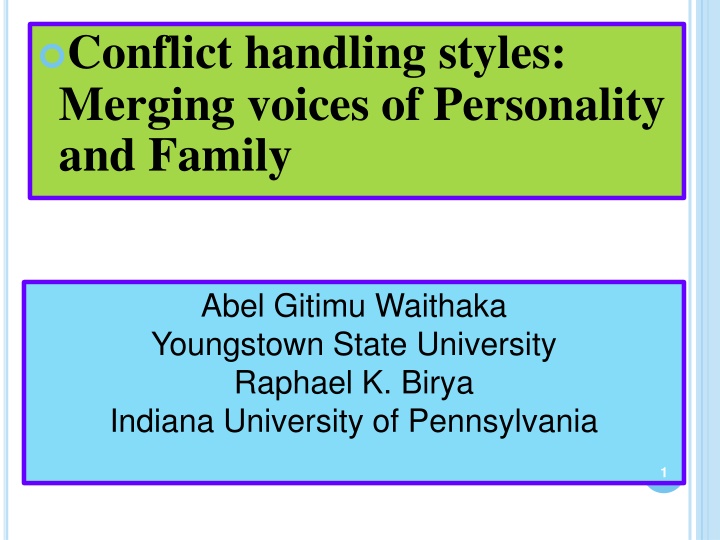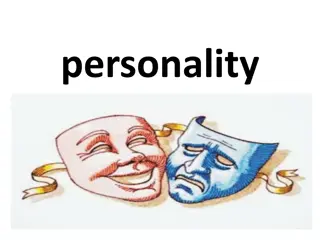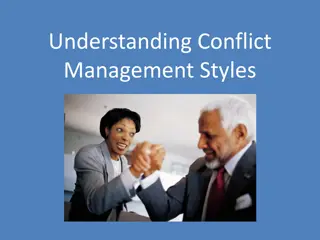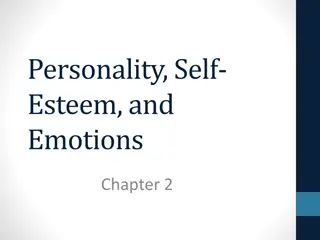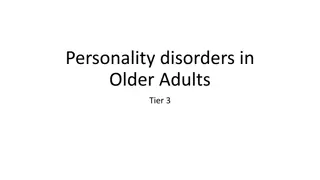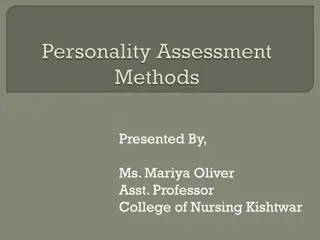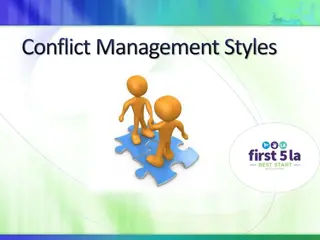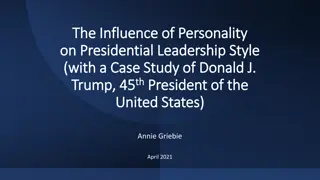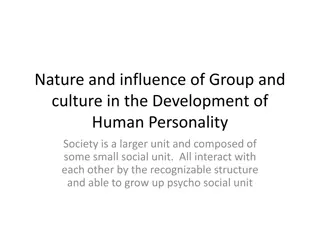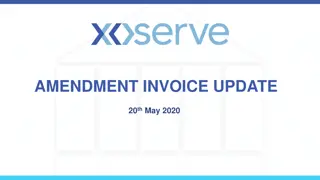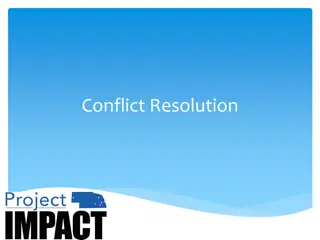Conflict Handling Styles: Influence of Personality and Family Conflict Resolution
This study examines how personality traits and family conflict resolution impact the conflict handling styles of college students. It includes research questions, instrumentation details, and MANOVA results on Big Five Inventory traits and conflict modes.
Download Presentation

Please find below an Image/Link to download the presentation.
The content on the website is provided AS IS for your information and personal use only. It may not be sold, licensed, or shared on other websites without obtaining consent from the author.If you encounter any issues during the download, it is possible that the publisher has removed the file from their server.
You are allowed to download the files provided on this website for personal or commercial use, subject to the condition that they are used lawfully. All files are the property of their respective owners.
The content on the website is provided AS IS for your information and personal use only. It may not be sold, licensed, or shared on other websites without obtaining consent from the author.
E N D
Presentation Transcript
Conflict handling styles: Merging voices of Personality and Family Abel Gitimu Waithaka Youngstown State University Raphael K. Birya Indiana University of Pennsylvania 1
PURPOSEOFTHESTUDY The purpose of the study was to examine the influence of personality and family conflict resolution on conflict handling styles of college students. 2
RESEARCH QUESTION RQ Is there a statistically significant difference in how personality and family conflict resolution influence an individual s conflict handling style? 3
Instrumentation: Thomas Kilmann Conflict Mode Instrument (MODE) Measures conflict handling styles. Allocates individuals into two dimensions in dealing with conflict. 1. Assertiveness (satisfy one concerns). 2. Cooperativeness (satisfy concerns for others). 4
http://www.earthpm.com/wp-content/uploads/2010/03/tkmodel1-1024x707.jpghttp://www.earthpm.com/wp-content/uploads/2010/03/tkmodel1-1024x707.jpg 5
INSTRUMENTATION The Five Big Inventory Instrument: Personality measured includes: 1. Extraversion 2. Agreeableness 3. Conscientiousness 4. Neuroticism 5. Openness 6
INSTRUMENTATION 3. Family conflict resolution scale (FCRS) Consists of 18 items 17 of items provide a total score for family conflict resolution. 7
MANOVA OF BIG FIVE INVENTORY (BFI) BY CONFLICT HANDLING MODE MANOVA was conducted with Thomas- Kilmann conflict MODE styles as the dependent variables and each of the five personalities as measured by BFI personality instrument as the factor or independent variable. MANOVA results indicated significant effect was found for personality of Extraversion and Agreeableness on conflict handling MODE. *Please see more details on the table in the next slide 8
MANOVA OF BIG FIVE INVENTORY (BFI) BY CONFLICT HANDLING MODE Multivariate Testsa Value F Error df Sig. Effect Wilks' Lambda Hypothesis df Extraversion .645 1.402 108.000 1296.623 .006* .632 1.414 112.000 1293.357 .004* Agreeableness .711 1.116 104.000 1295.835 .207 Conscientiousness .687 1.100 116.000 1290.018 .228 Neuroticism .690 1.172 108.000 1298.000 .114 Openness 9
ANOVA OF BIG FIVE INVENTORY (BFI) BY CONFLICT HANDLING MODE One Way ANOVA was conducted with Thomas- Kilmann conflict MODE and the two BFI personalities that showed significant effect in the MANOVA (Extraversion and Agreeableness). Extraversion personality showed statistically significant difference on conflict handling styles for competing and avoiding. Agreeableness personality showed statistically significant difference on conflict handling styles for competing and accommodating * Please see more details on the table in the next slide 10
ANOVA OF BIG FIVE INVENTORY (BFI) BY CONFLICT HANDLING MODE F Sig. BFI MODE Subscales Mean Square Subscales Competing 15.168 2.018 .002* Extraversion Collaboration 4.662 1.098 .340 Compromising 4.768 1.042 .410 Avoiding 8.975 2.172 .001* Accommodating 5.395 1.109 .327 Competing 13.484 1.766 .011* Agreeableness Collaboration 5.459 1.307 .142 Compromising 6.535 1.477 .060 Avoiding 3.834 .841 .701 Accommodating 7.767 1.666 .021* 11
ANOVA OF FAMILY CONFLICT RESOLUTIONBY MODE One Way ANOVA was conducted with Thomas-Kilmann conflict MODE styles as the dependent variables and the Family Conflict Resolution scale totals as the independent variable. The results showed that there was no statistically significant difference in how participants family conflict resolution totals impacted conflict handling styles. * Please see more details on the table in the next slide 12
ANOVA FAMILY CONFLICT RESOLUTIONBY MODE Mean F Sig. Square 6.639 .806 .761 COMPETING 3.040 .691 .893 COLLABORATING 4.806 1.052 .396 COMPROMISING 4.448 .987 .490 AVOIDING 3.342 .661 .918 13 ACCOMMODATING
SUMMARY, CONCLUSIONAND RECOMMENDATIONS Influence of BFI personality on MODE conflict handling styles MANOVA indicated significant influence on two BFI personalities (Extraversion and Agreeableness). ANOVA results showed a statistically significant difference in some subscales of personality and some conflict handling styles. Extraversion was statistically significant on Competing and Avoiding styles Agreeableness was statistically significant to competing and Accommodating styles. 14
FINDINGSFROMOTHERSTUDIES This evidence supports research findings that indicate some personality tends to influence the choice of conflict handling styles (Moberg, 2001). The current study did not agree with Olekalns and Smith (1999) study that argued that individuals with high extraversion tend to use integrating and compromising styles while handling conflicts (Olekalns & Smith, 1999). This finding concurs with Kilpatrick and Johnson s, (2001) study that reasoned that agreeableness is characterized by a strong motivation to maintain positive relationships with other people involved in a conflict. 15
INFLUENCEOFFAMILYCONFLICTRESOLUTION ON MODE CONFLICTHANDLINGSTYLES ANOVA showed no statistically significant difference on how participants family conflict resolution impacted conflict handling styles in all the subscales. All participants regardless of their age, ethnicity or year of study indicated no significant difference on how their family influences their MODE of conflict handling. 16
FINDINGSFROMOTHERSTUDIES The results defy the Social learning theory and the coercion theory Social learning theory predicts that behavior patterns learned in the family are practiced in young adulthood (Andrews, Foster, Capaldi, & Hops, 2000). Coercion theory predicts that infective parental conflict management styles will produce coercive, unskilled responses to family, young adult, and peer relationships (Andrews, at el., 2000). 17
FINDINGSFROMOTHERSTUDIES Amett (1999) noted, intergenerational family conflict between parents and children is usually on the rise during early adolescence and declines by late adolescence and young adulthood The movement from home to college leads to further loosen parental control, and this results in a decrease in overall family conflict (Lee, Su, & Yoshida, 2005). 18
CONCLUSION MANOVA indicated that there was significant influence of two BFI personalities (Extraversion and Agreeableness) on the conflict handling styles as measured by the MODE instrument. ANOVA indicated there was no impact of family conflict resolution on conflict handling styles. 19
References Antonioni, D (1999).Predicting approaches to conflict resolution from big five personality, Madison, WI: University of Wisconsin. Bandura, A. (1977). Social learning theory. Englewood Cliffs, NJ: Prentice Hall. Breunlin, D. C., Cimmarusti, R. A., Bryant-Edwards, T. L., & Hetherington, J. S. (2002). Conflict Resolution Training as an Alternative to Suspension for Violent Behavior. Journal of Educational Research, 95(6), 349. Connolly, J., White, D., Stevens, R., & Burstein, L. (1987), Adolescent self-reports of social activity: Assessment of stability and relations to social adjustment. Journal of Adolescence,10, 83- 95. Costa, P. T., & McCrae, R. R. (1995). Solid ground in wetland: A reply to block. Psychological Bulletin, 117, 216-220. Dadds, M. R., Atkinson. E., Turner, C., Blums, G. J., Lendich, B. (1999). Family conflict and child adjustment: Evidence for a cognitive contextual model in intergenerational transmission. Journal of Family Psychology, 13, 194-208. Johnson, D. W., & Johnson, R. (1996). Conflict resolution and peer mediation programs in elementary and secondary schools: A review of the research. Review of Educational Research, 66, 459 506. 20
REFERENCES Katz, L. F., & Woodin. E. M. (2002). Hostility, hostility detachment, and conflict engagement in marriage: effects of child and family functioning. Child Development, 73, 636-652. Moskowitz, D. S., & Cote, S. (1995). Do interpersonal traits predictaffect? A comparision of three models. Journal of Personality and Social Psychology, 69, 630-637. Park, H. & Antonioni, D. (2007). Personality, reciprocity, and strength of conflict resolution strategy. Journal of Research in Personality,41, 110-125. Reese-Weber, M. (2000). Middle and late adolescents conflict resolution skills with siblings: Associations with interparental and parent- adolescent conflict resolution. Journal of Youth Adolescence, 29, 6, 697-711 Stevahn, L. (2004). Integrating conflict resolution training into the curriculum. Theory Into Practice, 43(1), 50-58. Stevahn, L., Johnson, D. W., Johnson, R. T., & Schultz, R. (2002). Effects of conflict resolution training integrated into a high school social studies curriculum. Journal of Social Psychology, 142(3), 305-331. Tedeschi, J., and R. Felson. 1994. Violence, aggression, & coercive actions.Washington, DC: American Psychological Association. 21
